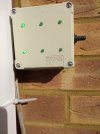So I bought some LEDs and small bulbs yesterday to have a play with scratch building some signals for my garden railway. I have some questions on how to wire them up.
For reference, supply is a Roco z21 XL DCC system, putting roughly 20V across the tracks.
I'm using a mix of LGB 55525 (and equivalent) and Zimo MX820V to drive my turnouts. The MX820Y has signal outputs as well as turnout outputs - I could install a few of these and use their outputs to provide DC to the LEDs. I think I need a 1k resistor also (MX820E manual, diagram page 14).
Are there other good alternatives?
Once I have the DC problem sorted, I need to handle current. Is it OK to use a single current limiter (resistor or regulator) on the common anode? Or am I better to put a separate resistor on each LED? For small LEDs, is there any benefit to using a "driver" (as they seem to be called), or is an appropriately sized resistor a better option?
How do I calculate the right resistor? Both LEDs are specified as 2V and up to 30mA. Using LED Calculator with 20V / 30mA / 2V gives a 620 Ohm resistor. Does this sound correct?
I deliberately got a 3 input LED for the red/green version so I could switch between the inputs using a single pole rather than requiring a full DPDT to reverse current for a 2 input LED.
For reference, supply is a Roco z21 XL DCC system, putting roughly 20V across the tracks.
Bulbs
Got a couple of 12V bulbs, 120mA current. ( 12V Lilliput Globes )- I assume that these can handle the "AC" current from the track and don't need the source current to be rectified.
- How do I calculate the resistor value required to drop the power to something that won't burn out the globe?
- Is a resistor the right way to go? Or should I run a separate power feed for the 12V lights?
LEDs
Playing with 2 different products:- Red/Green LEDs with their own mount ( Chrome Bezel with 5mm Green LED )
- Tri-colour LEDs ( Tricolour Red/Green/Orange 3mm LED 4.5/6mcd Round Diffused )
I'm using a mix of LGB 55525 (and equivalent) and Zimo MX820V to drive my turnouts. The MX820Y has signal outputs as well as turnout outputs - I could install a few of these and use their outputs to provide DC to the LEDs. I think I need a 1k resistor also (MX820E manual, diagram page 14).
Are there other good alternatives?
Once I have the DC problem sorted, I need to handle current. Is it OK to use a single current limiter (resistor or regulator) on the common anode? Or am I better to put a separate resistor on each LED? For small LEDs, is there any benefit to using a "driver" (as they seem to be called), or is an appropriately sized resistor a better option?
How do I calculate the right resistor? Both LEDs are specified as 2V and up to 30mA. Using LED Calculator with 20V / 30mA / 2V gives a 620 Ohm resistor. Does this sound correct?
Switching
My initial plan was to simply switch the signals on/off using an LGB supplementary switch attached to the EPL drive. The supplementary switch is a DPDT, so I can use one pole as a SPDT which switches power between two lights (e.g. "red" or "green"). I realise this isn't necessarily prototypical, but it works for a first cut. Are there better ways to do it? At this stage, I'd rather tie the signals directly to the turnouts rather than manage them separately.I deliberately got a 3 input LED for the red/green version so I could switch between the inputs using a single pole rather than requiring a full DPDT to reverse current for a 2 input LED.

